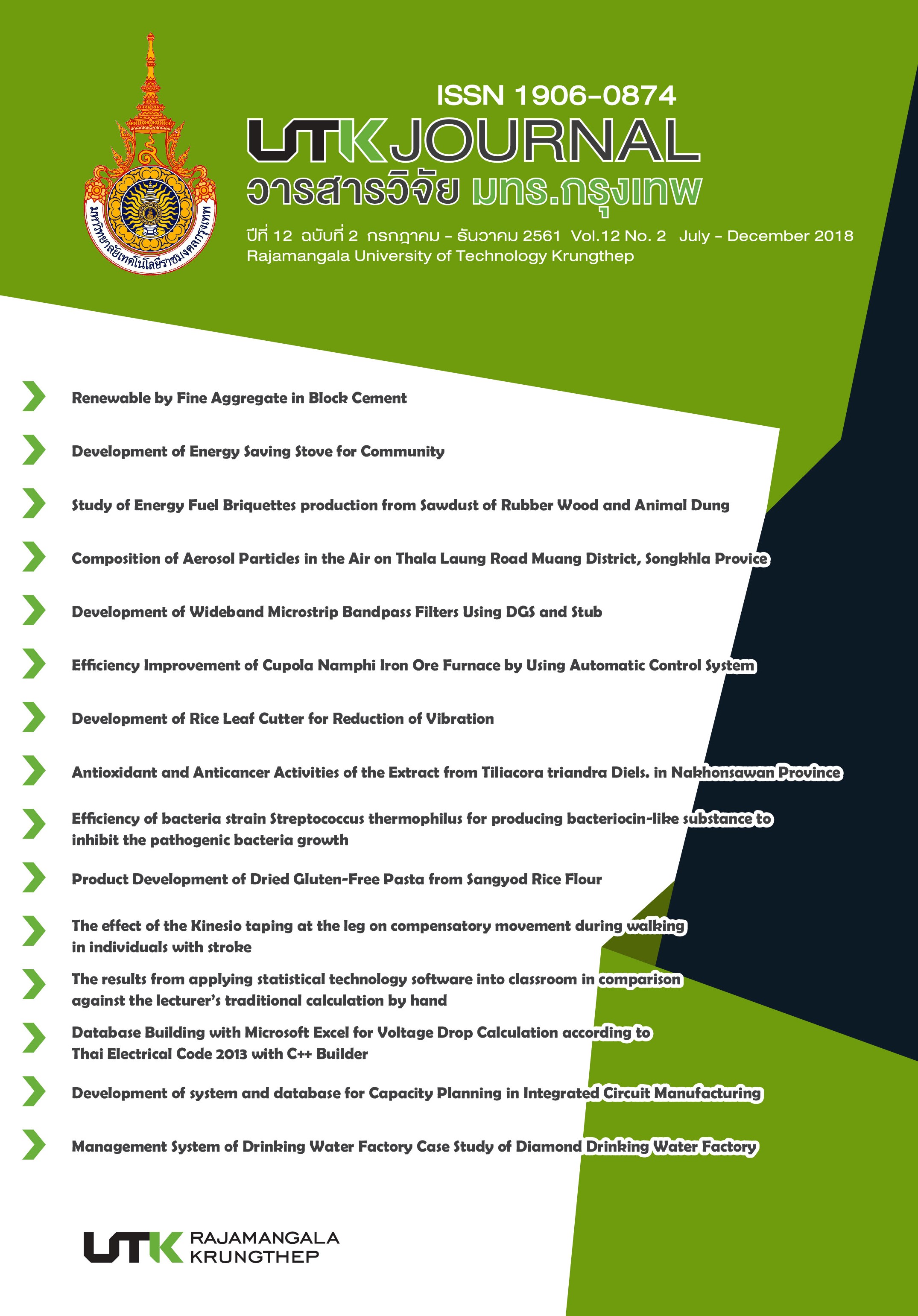Development of Energy Saving Stove for Community
Keywords:
Biomass, Biomass stove, Energy Saving StoveAbstract
The objective of this research was to develop biomass stove using agricultural residue to reduce fuel cost for farmers and to recycle waste from agriculture to fuel. The research consisted of the design of the biomass stove which modified based on the model used in the villages e.g. Khanoom Jeen making stove. The agricultural residues including husk and saw dust were tested as fuel source. The designed biomass stove was up draft flow type. The stove body was made from the mixtures of cement : sand : stone with 5 different ratios; A (3 : 1 : 3), B (2 : 2 : 3),C (2 : 3 : 2), D (3 : 2 : 2) and E (3 : 3 : 1). Plastering material was prepared from clay: husk ash at three ratios; F (1 : 1), G (2 : 1) and H (1 : 2). The thermal tolerant property was tested and found that the stove body with ratio B gave the best thermal tolerant at 800 ℃ for 1 hour. The three plastering ratios gave similar thermal tolerant property at 800 ℃ for 1 hour. This optimum mixture was used for making the stove with the size of 0.20 m diameter and 0.70 m height. The volume of the stove was 0.10 m3 and the average efficiency of the stove was 39.82% and this was similar to community biomass stove 40.82%.
References
74.
[2] ธนากร หอมจำปา, คมสันต์ ทองปัญญา, ณัฐพร กรรมพระอินทร์, แสงเทียน กุหลาบ และประพันธ์พงษ์ สมศิลา. การศึกษา
ปัจจัยที่มีผลต่อประสิทธิภาพเชิงความร้อนของเตาชีวมวลสำหรับครัวเรือน. วารสารวิทยาศาสตร์ มหาวิทยาลัยเทคโนโลยีราชมงคลอีสาน 2557; 7(2):103 – 10.
[3] สมภักดิ์ ถึงปัดชา. การพัฒนาเตาชีวมวลโดยใช้เถ้าแกลบปูนซีเมนต์ปอร์ตแลนด์ 1. วิทยานิพนธ์หมหาบัณฑิต, สาขาวิทยาศาสตร์ศึกษา, มหาวิทยาลัยราชภัฏอุบลราชธานี; 2558.
[4] Annual Book of ASTM Standard. Standard Test Method for Moisture in Activated Carbon D2867-95. 15.01. 709-711. United State of America; 1998
[5] Annual Book of ASTM Standard. Standard Test Method for Total Ash Content of Activated Carbon D2866-94. 15.01. 707-708. United State of America; 1998.
[6] Annual Book of ASTM Standard. Standard Test Method for Total Volatile Matter Content of Activated Carbon Sample D5832-95. 15.01. 782. United State of America; 1998.
[7] McGill KC., Yasechko, ML., Nkari WK. Determinaton of Calories in Food Via Adiabatic Bomb Calorimeter. The Corinthian, Vol. 6, Article 9; 2004.
[8] พงศ์พน วรสุนทโรสถ และวรพงศ์ วรสุนทโรสถ. วัสดุก่อสร้า. ซีเอ็ดยูเคชั่น, กรุงเทพฯ; 2544. หน้า 86.
[9] สาโจน์ ขาวดี. การศึกษาคุณสมบัติพื้นฐานทางกายภาของอิฐทนไฟโดยใช้ทรายชัยนาทเป็นวัตถุดิบหลัก. วิทยานิพนธ์วิศวกรรมมหาบัณฑิต สาขาวิศวกรรมโยธาคณะวิศวกรรมศาสตร์ มหาวิทยาลัยเทคโนโลยีพระจอมเกล้าธนบุรี; กรุงเทพมหานคร; 2544.
Downloads
Published
Issue
Section
License
กองบรรณาธิการวารสารวิชาการ มหาวิทยาลัยเทคโนโลยีราชมงคลกรุงเทพ มีความยินดีที่จะรับบทความจากอาจารย์ นักวิจัย นักวิชาการทั้งภายในและภายนอกมหาวิทยาลัย ในสาขาวิชาวิทยาศาสตร์และเทคโนโลยี ได้แก่ สาขาวิชาวิทยาศาสตร์ วิศวกรรมศาสตร์ และสาขาอื่นๆ ที่เกี่ยวข้อง รวมถึงสาขาต่างๆ ที่มีการบูรณาการข้ามศาสตร์ที่เกี่ยวข้องวิทยาศาสตร์และเทคโนโลยี ที่เขียนเป็นภาษาไทยหรือภาษาอังกฤษ ซึ่งผลงานวิชาการที่ส่งมาขอตีพิมพ์ต้องไม่เคยเผยแพร่ในสิ่งพิมพ์อื่นใดมาก่อน และต้องไม่อยู่ในระหว่างการพิจารณาของวารสารอื่น
การละเมิดลิขสิทธิ์ถือเป็นความรับผิดชอบของผู้ส่งบทความโดยตรง บทความที่ได้รับการตีพิมพ์ต้องผ่านการพิจารณากลั่นกรองคุณภาพจากผู้ทรงคุณวุฒิและได้รับความเห็นชอบจากกองบรรณาธิการ
ข้อความที่ปรากฏอยู่ในแต่ละบทความที่ตีพิมพ์ในวารสารวิชาการเล่มนี้ เป็นความคิดเห็นส่วนตัวของผู้เขียนแต่ละท่าน ไม่เกี่ยวข้องกับมหาวิทยาลัยเทคโนโลยีราชมงคลกรุงเทพแต่อย่างใด ความรับผิดชอบด้านเนื้อหาและการตรวจร่างบทความแต่ละบทความเป็นของผู้เขียนแต่ละท่าน หากมีความผิดพลาดใดๆ ผู้เขียนแต่ละท่านจะต้องรับผิดชอบบทความของตนเองแต่ผู้เดียว
กองบรรณาธิการขอสงวนสิทธิ์มิให้นำเนื้อหา หรือข้อคิดเห็นใดๆ ของบทความในวารสารวิชาการ มหาวิทยาลัยเทคโนโลยีราชมงคลกรุงเทพ ไปเผยแพร่ก่อนได้รับอนุญาตจากกองบรรณาธิการ อย่างเป็นลายลักษณ์อักษร ผลงานที่ได้รับการตีพิมพ์ถือเป็นลิขสิทธิ์ของวารสาร





